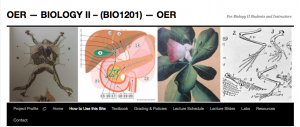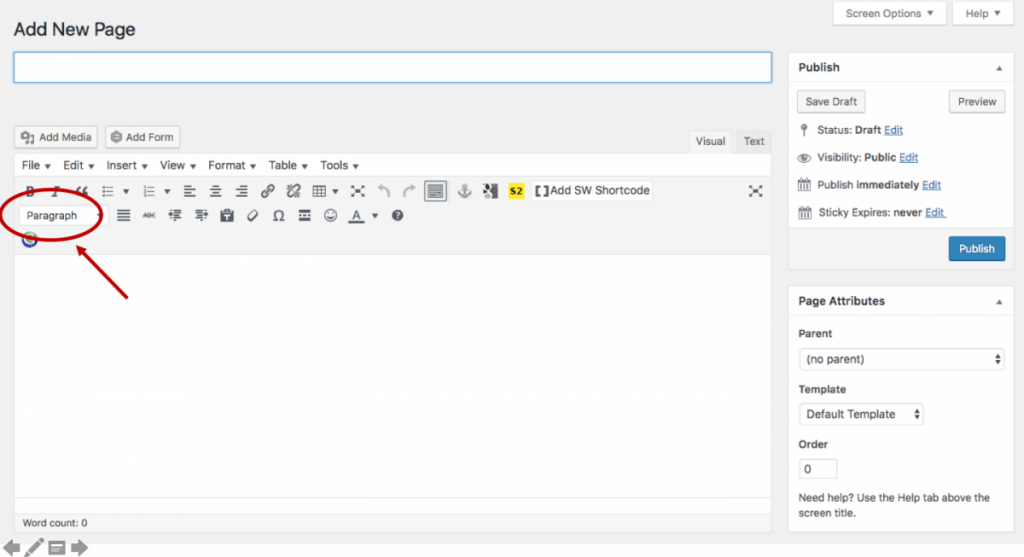
This week we’re spotlighting an open educational resource (OER) created by Professor Tatiana Voza for Biology II (1201) using a project site on the OpenLab. You can learn more about OERs and OERs at City Tech below, but in general, OERs are online educational resources that are open, easily accessible, and freely available to the public. This description is both meaningful – given its contrast with dominant practices in the academy – and ambiguous. This spotlight on Professor Voza’s site is the beginning of a 3-part series spotlighting Open Educational Resources on the OpenLab. This series aims to introduce you to the variety of OERs available on the OpenLab – some of which may be of use to City Tech students – and to show you to how some faculty at City Tech are implementing OERs on the OpenLab. Each part will focus on a particular quality of the OER, why it matters, and how the spotlighted site achieves it.
Part 1 focuses on clarity and organization.
When you first visit to Professor Voza’s Biology II OER, you are greeted with a welcoming, easily navigable introduction tailored to the role of the visitor (are you a student or a faculty?). Each section helps the visitor get oriented to the site by breaking down how each user-type may use the site: Are you a professor preparing your class? Are you a student trying to use this site to study for an exam?
The clear, instructional and organized nature of the page is mimicked throughout the site. This is a very useful strategy when building an OER. In your class, when things are unclear, students can clarify instructions and tasks with professors in class and/or via follow-up communication. However, with OERs, the aim is for other faculty and students beyond your class to adopt and adapt your materials for their own purposes. In this scenario, the lack of familiarity and proximity between user and creator combined with a lack of understanding about how to use and navigate the site could discourage visitors from using the OER altogether.
Relatedly, being clear that your site is an OER and that to a greater or lesser degree the material can be used and remixed by others, is equally important. On this OER site, a reminder in the form a description of the Creative Commons license is visible in the sidebar on every page.
Another feature of Professor Voza’s OER that assists in presenting the content in a clear and easily digestible way is the use of the Table of Contents Plus plugin. Upon activating this plugin, introductory Table of Contents (TOC) boxes automatically appear on all pages across the site that include 3 or more ‘Headings’ (see image). Including a TOC, especially on pages with a lot of content assists users in quickly understanding what a page contains and navigating to content of interest. The Table of Contents Plug plugin is easy to use, great for organization on any site, and can easily be activated on your own sites by going to Dashboard > Plugins.

What are Open Educational Resources?
Open Educational Resources, or OERs, are just what they sound like – educational resources that are open, easily accessible, and freely available to the public. In the context of higher education at CUNY, OERs are discussed in relation to alleviating textbook costs for students. This is significant given that these costs too often play a role in the direction of studies a student may pursue, and/or may prevent a student from completing their studies all together. In addition to making higher education more affordable, OERs create transparency around course curriculum, allowing faculty to easily share the details, content, and organization of their courses. In this way, OERs promote culture of sharing, remixing and collaboration.
OERs at City Tech
Since 2015, City Tech’s OER Fellowship program has supported 25 faculty create and curate Open Educational Resources for a course of theirs on the OpenLab. Fellows are full-time faculty members representing a diversity of departments including Construction Management and Civil Engineering Technology, Biological Sciences, Social Sciences, African American Studies, Computer Science Technology and Dental Hygiene – to name a few. A full list of fellows and their OERs can be found on the OER Fellowship site hosted on the OpenLab. OERs on the OpenLab, however, are not limited to this list; other faculty have taken it upon themselves to develop OERs for City Tech’s community.
Further reading to learn more about OERs:
- Event info and Recap of our Fall 2016 Event on Open Educational Resources (includes additional resources).
- Spotlight on City Tech’s OER Fellowship



